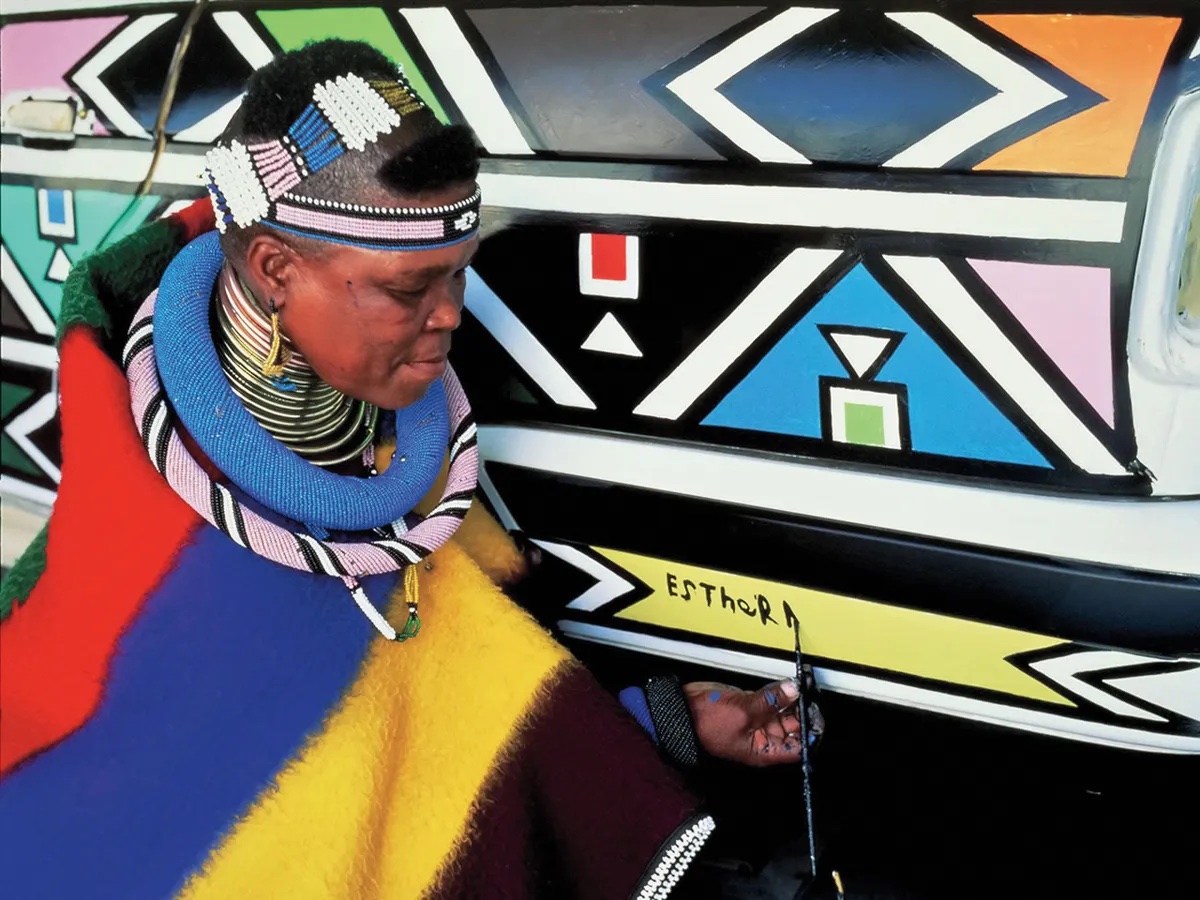

In 1989 Esther Mahlangu (b. 1935) participated in “Magiciens de la terre” at the Pompidou Center in Paris. One of the first exhibitions to mingle artists from across the globe, it remains influential—largely for the troubling issues it raised. One critic, Rasheed Araeen, pointed out the “biases of the way in which the organizers of the exhibition selected artists—searching for the ‘authentic,’ bypassing anything truly modern in Third World cultures.”
Decades later, critics and curators are still grappling with the politics of inserting artists from the Global South into the citadel of modernity. Mahlangu’s retrospective, “Then I Knew I Was Good at Painting” at Iziko National Gallery in Cape Town, takes a new approach to the old question. The curator, Nontobeko Ntombela, reframes Mahlangu’s practice squarely within the modernist tradition of artists who challenge entrenched processes of making through innovation. Mahlangu’s paintings, beadwork, tapestries, and found objects fully metabolize both the traditional and the contemporary, resulting in a kind of modernism that is uniquely African.

Mahlangu started painting as a young girl, using the walls of her home. Unsurprisingly, her family discouraged this. But she continued to paint in secret, overtaking the home’s outer walls. Eventually, her family noticed her progress—and congratulated her. “Then I knew I was good at painting,” she proclaimed. For her, this affirmation marked a radical shift in how she understood her activity: it was no longer simply an act of rebellion, but a productive artistic engagement.
For seven decades, Mahlangu has painted vivid geometric forms and detailed patterns that draw from a long history of Ndebele mural painting, a technique passed between generations of women. By continuing this tradition, she honors the many women who used patterns as secret codes to share personal prayers, emotional journeys, and collective values. Her work is a profound exploration of the spaces between the organic (natural pigment and materials) and the crafted (beadworks), between the traditional (Ndebele mural paintings) and the modern (abstract geometric compositions rendered in acrylic).

This historical context helps clarify the stakes involved in her retrospective exhibition: It is a moment of validation and recognition of her talent that challenges the historical marginalization of work by women. At the same time, it highlights the resilience and creativity of Black women artists. And it shows how work can at once draw from tradition and be modern.

A timeline in the exhibition reveals a crucial moment in Mahlangu’s career: from 1980 to ’91, she lived at the Botshabelo Historical Village, an open-air museum where Ndebele culture is displayed and preserved. There, she made murals that caught the eyes of the French curators organizing “Magiciens de la terre.” The retrospective runs through the early 1990s, when Mahlangu started painting on canvas and showing in museums. In that decade, she also began receiving commissions from brands like BMW and Comme des Garçons, evidence of a cultural trend toward “multiculturalism”—and attendant interest in African art—that characterized the decade. The show culminates in more recent times, as work by women artists is finally entering the canon; though prolific and beloved, Mahlangu secured her first solo exhibition in South Africa only in 2003, at the Irma Stern Museum in Cape Town.

Mahlangu painted on houses, canvases, and everyday objects—including vessels, ballroom shoes, and makarapa, the hard hat worn by sports fans in South Africa. BMW commissioned her to paint a 525i (E34), part of a program that began in 1975 with Alexander Calder’s BMW 3.0 CSL, and was followed by models painted by Frank Stella in 1976, Roy Lichtenstein in 1977, and Andy Warhol in 1979. Mahlangu’s 1991 edition made her the first woman and the first African on the list; Julie Mehretu was selected for 2024. In the corporate project, as in her everyday found objects, she paints the exterior with her signature patterns; it isn’t totally clear what her commentary is, if any. Perhaps she simply painted whatever surfaces were available to her—adorning every square centimeter of the car, including its hubcaps.

Mahlangu’s work has been widely exhibited across the globe since 1989, and yet, her work is rarely considered for its formal innovation: critics and curators tend to focus on her origin story, and her sources of inspiration; while they write about Euro-American abstract painters as making work evoking a universal human condition, they read abstractions by artists from the Global South, like Mahlangu, as culturally specific. This retrospective maintains a similar biographical and regional focus, but Mahlangu’s graceful forms make a case for themselves nevertheless: her arrangements of colors are considered and consistent, but they do not match. She contrived an apparatus—a black-and-white rectangular frame, with geometric patterns inside and out—that she retooled in seemingly infinite configurations.
The need to redress Black modernisms from the Global South remains, and is an impossible task for a single artist to shoulder. But it helps that her paintings carry with them the contributions of generations of Ndebele women.